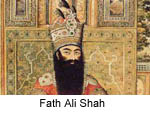|
|
 Agha Mohammad Qajar defeated the last Zand ruler outside Kerman in 1794 and made himself master of the country, beginning the Qajar dynasty that was to last until 1925. Under Fath Ali (1797-1834), Mohammad Shah (1834-48), and Naser ad Din Shah (1848-96) a degree of order, stability, and unity returned to the country. Agha Mohammad Qajar defeated the last Zand ruler outside Kerman in 1794 and made himself master of the country, beginning the Qajar dynasty that was to last until 1925. Under Fath Ali (1797-1834), Mohammad Shah (1834-48), and Naser ad Din Shah (1848-96) a degree of order, stability, and unity returned to the country.
The Qajars revived the concept of the shah as the shadow of God on earth and exercised absolute powers over the servants of the state. They appointed royal princes to provincial governorships and, in the course of the nineteenth century, increased their power in relation to that of the tribal chiefs, who provided contingents for the shah's army. Under the Qajars, the merchants and the ulama, or religious leaders, remained important members of the community. A large bureaucracy assisted the chief officers of the state, and, in the second half of the nineteenth century, new ministries and offices were created.
|
| Important events | |
War with RussiaWar with BritainDeath of the prime miniter and reformer Amîr Kabîr (1852 A.D.)The Persian Constitutional Revolution (1905 A.D.)First Majles (Majlis) founded (1907)1st world war |
|
|
King
Âqâ Mohammad Khân 1796 - 1797
Fath Alî Shâh 1797 - 1834
Mohammad Shâh 1834 - 1848
Nâser ed-Dîn Shâh 1848 - 1896
Mozaffar ed-Dîn Shâh 1896 - 1907
Mohammad Alî Shâh 1907 - 1909
Ahmad Shâh 1909 - 1925
|
The Constitutional Revolution
The shah's failure to respond to protests by the religious establishment, the merchants, and other classes led the merchants and clerical leaders in January 1906 to take sanctuary from probable arrest in mosques in Tehran and outside the capital. When the shah reneged on a promise to permit the establishment of a "house of justice," or consultative assembly, 10,000 people, led by the merchants, took sanctuary in June in the compound of the British legation in Tehran. In August the shah was forced to issue a decree promising a constitution. In October an elected assembly convened and drew up a constitution that provided for strict limitations on royal power, an elected parliament, or Majlis, with wide powers to represent the people, and a government with a cabinet subject to confirmation by the Majlis. The shah signed the constitution on December 30, 1906. He died five days later. The Supplementary Fundamental Laws approved in 1907 provided, within limits, for freedom of press, speech, and association, and for security of life and property.
|
Fath Ali Shah
He was succeeded in 1797 C.E. by his nephew, Fath 'Ali Shah (1797-1834), notable for his enormous beard and also for the way in which he used Art as means of propaganda. He distributed a large number of paintings of himself to foreign envoys. In all of these he sought to portray himself as the inheritor of a long imperial civilisation.
Fath 'Ali-Shah proved a unifying force in Iranian history. He instituted an age of opulence and refinement, leaving the conduct of the necessary wars to his sons, of whom there were 47! He cemented his power through relations with women from his own Qajar family as well as the defeatred Zand and Afsharid tribes. At his death in 1834 C.E. he left behind over 1,000 descendants. It was during his reign that political alliances were forged and re-forged with the great European and Asian powers. Their influence is clear in the art of the time, but there was also less acceptable meddling in the political and economic affairs of Iran.
Fath 'Ali Shah was succeeded by Muhammad Shah (1834-1848 C.E.) and Nasir al-Din Shah (1848-1896). The former was an autere and unwell monarch who lost touch with his people. It has been said that this loss of touch gave rise to the Bahai movement of the late 1840s which became a party of dissent. Muhammad Shah sought to end this through vigorous persecution of its adherents and re-establishement of Shi'ism and by 1852 the movement had been virtually suppressed.
|
Nasir al-Din Shah
Further internal difficulties followed the accession of Nasir al-Din Shah in 1848. His short-lived first minister (1848-1851) was the immensely fat, but highly capable, Amir Kabir. Amir Kabir chose the Bagh-e-Fin as his principal residence and it was in the Bath House there, that he met his untimely end at the hand of an assassin, hired by the Shah, in 1852 following his sacking in 1851. Amir Kabir had earned the dislike of his master by attempting to stamp out corruption and patronage.
The assassination of Viziers, or 'prime ministers' was not uncommon in these times. Fath 'Ali shah had executed his Vizier and so had Muhammad Shah, however, it led to instability and following the death of Amir Kabir, Iran sought compromise after compromise with Britain and Russia in an attempt to balance territorial integrity with the needs of the exchequer. THe losses of Herat and Merv provinces between 1856 and 1861 C.E. were however, arrested through this policy, although at the cost of real independence.
In 1873 Nasir al-Din undertook a tour of Europe from which he returned with misgivings based upon the apparent relationship with tyechnological advance and the growth of en empowered proletariat.
|
|

